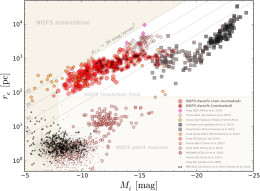Theories of galaxy formation and evolution predict that there should be significantly more dwarf galaxies than have been observed. Are our theories wrong? Or are dwarf galaxies just difficult to detect? Recent results from a survey of a galaxy cluster 62 million light-years away suggest there may be lots of undiscovered dwarf galaxies hiding throughout the universe!
Hiding in Faintness
The “missing dwarf problem” has had hints of a resolution with the recent discovery of Ultra-Diffuse Galaxies (UDGs) in the Coma and Virgo galaxy clusters. UDGs have low masses and large radii, resulting in a very low surface brightness that makes them extremely difficult to detect. If many dwarfs are UDGs, this could well explain why we’ve been missing them!
But the Coma and Virgo galaxy clusters are similar in that they’re both very massive. Are there UDGs in other galaxy clusters as well? To answer this question, an international team of scientists is running the Next Generation Fornax Survey (NGFS), a survey searching for faint dwarf galaxies in the central 30 square degrees of the Fornax galaxy cluster.
The NGFS uses near-UV and optical observations from the Dark Energy Camera mounted on the 4m Blanco Telescope in Chile. The survey is still underway, but in a recent publication led by Roberto P. Muñoz (Institute of Astrophysics at the Pontifical Catholic University of Chile), the team has released an overview of the first results from only the central 3 square degrees of the NGFS field.
Surprising Detection

Galaxy radii vs. their absolute i-band magnitudes, for the dwarfs found in NGFS as well as other stellar systems in the nearby universe. The NGFS dwarfs are similar to the ultra-diffuse dwarfs found in the Virgo and Coma clusters, but are several orders of magnitude fainter. [Muñoz et al. 2015]
And at the faint end of the sample, the authors find additional extremely low-surface-brightness dwarfs that are several orders of magnitude fainter even than classical UDGs.
The authors describe the properties of these galaxies and compare them to systems like classical UDGs and dwarf spheroidal galaxies in our own Local Cluster. The next step is to determine which of the differences between the sample of NGFS dwarfs and previously known systems are explained by the environmental factors of their host cluster, and which are simply due to sample biases.
With much more data from the NGFS still to come, it seems likely that we will soon be able to examine an even larger sample of no-longer-missing dwarfs!
Citation
Roberto P. Muñoz et al 2015 ApJ 813 L15. doi:10.1088/2041-8205/813/1/L15
